Chances are you’ve seen a lady beetle, sometimes known better as a “ladybug,” and could pick one out of a lineup. But how much do you really know about them? Are they all female? Do they eat our plants? Why do they come into our house in the fall? Where do they go in the winter?
This blog will answer those questions and many more. Prepare to take a deep dive into the miniature world of lady beetles!
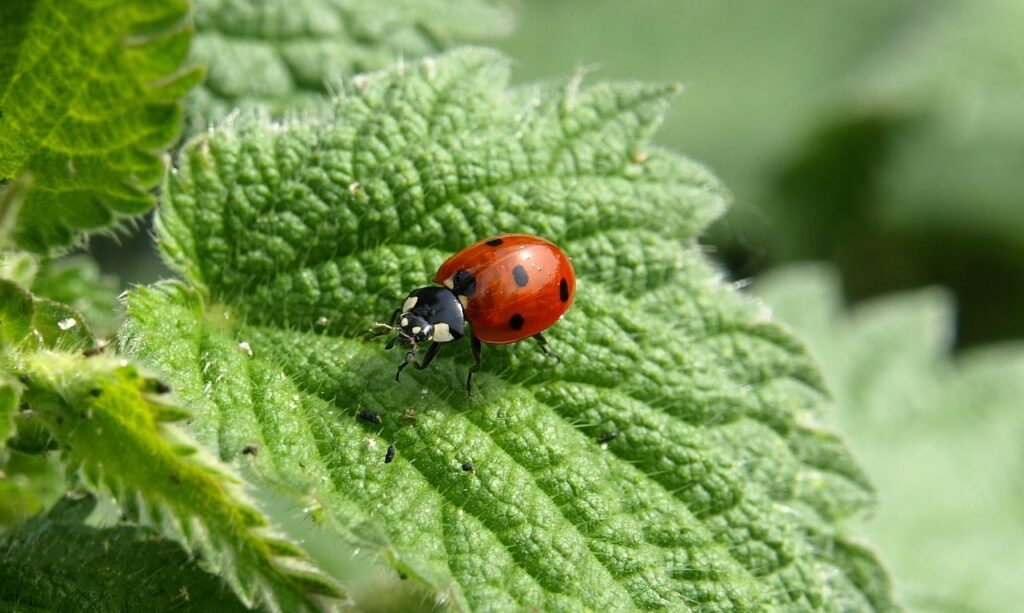
The family Coccinellidae (pronounced “kok-si-NEL-li-dee”) contains more than 6,000 species worldwide. You can find coccinellids on every continent except Antarctica and in a variety of habitats, from the tree canopy, to plant leaves, to leaf litter.
Most lady beetles are predators of other insects, which is why they’ve garnered “beneficial bug” status. We like to have predators in the garden. They keep populations of pest insects—those that like to eat our plants—in check, and they signal that we have a healthy, balanced ecosystem. Lady beetles are generalists, feeding on a variety of different types of insects as long as they’re in the right size range. Common prey for lady beetles includes aphids, mites, scale insects, and whitefly eggs and nymphs.
Despite their name, not all lady beetles are female. The origins of the name date back to European farmers, who would pray to the Virgin Mary to protect their crops. Possibly because of lady beetles’ role as predators, or even their red color, which may have reminded Europeans of the red cloak Mary wears in medieval depictions, this common name for insects in the family Coccinellidae stuck!
Description
Eggs
Many lady beetles have bright yellow or yellowish-orange eggs laid standing upright in clusters of 20 or fewer.
Fun fact: adult lady beetles often strategically lay their eggs on the undersides of leaves that are infested with insect prey so when her larvae hatch they have plenty of food to chow down on!
Larvae
The larvae look quite different from the adults. It’s helpful to know what all the life stages look like so you can identify and protect them in your garden.
Lady beetle larvae are 0.2-1 inch long, usually with an elongated and tapered body. Larvae have well-developed heads, legs, and fleshy bumps and spines on their abdomens. Some say they look like little alligators! Just like adults, the larvae eat other insects, so it helps for them to have hardy legs for running down prey and well-developed mandibles for chewing.
According to Art Evans, “Lady beetle larvae have voracious appetites from the moment they hatch. Their first meals may consist of their egg’s shell, unhatched eggs, and/or their siblings.”
Pupae
From the larval stage, a lady beetle molts into a pupa. The pupal stage is a time of transition, where the beetle undergoes a dramatic rearrangement of its physical features. They are immobile and vulnerable during this time and are often attached to the surface of a leaf or in some other protected location. A lady beetle may remain in its pupal stage for 10 days or more before emerging as an adult.
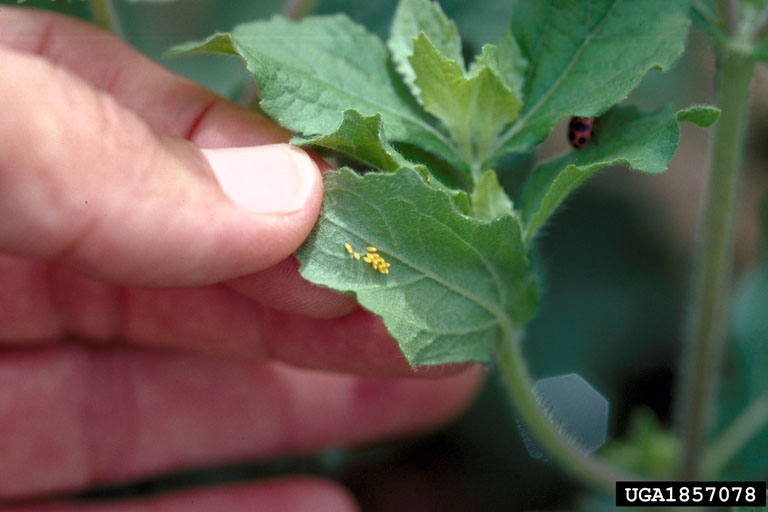
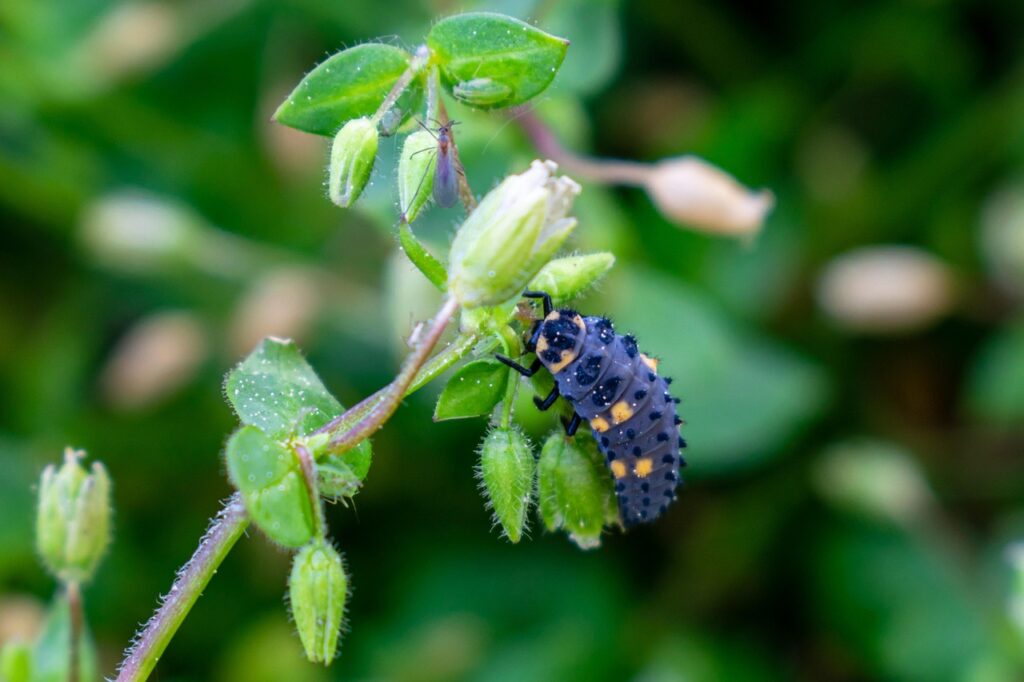
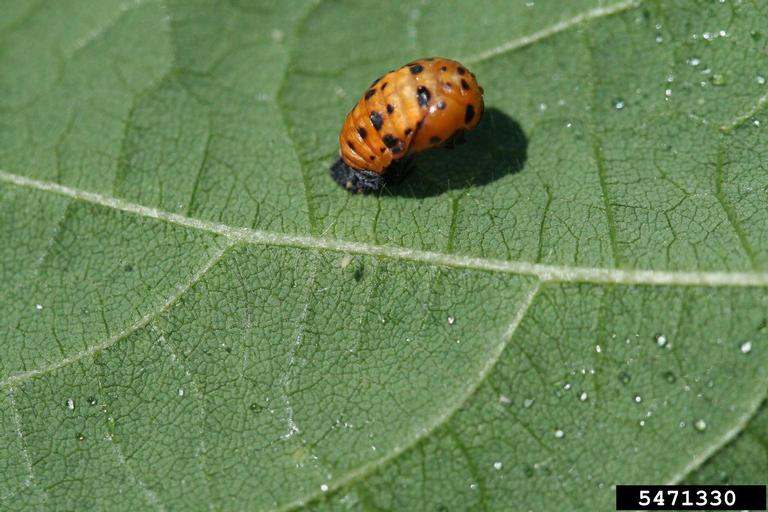
Adults
In general, adult coccinellids are 0.03-0.7 inches long with domed backs and flattened undersides (like a tortoise). They have large, compound eyes that help them detect prey and their surroundings, and strong, sharp mandibles, which they use to capture and consume other insects. Their pronotum, the front part of the thorax, is broad, domed, and often covers the back of the head, contributing to their overall rounded shape.
Their elytra, the hardened forewings characteristic of beetles, are what give lady beetles their round look. Elytra have evolved to protect beetles’ fragile hind wings from twigs, leaves, and other debris they may encounter in their environment. When a lady beetle flies off (yes, they fly!), they rotate their elytra sideways and literally unfold their thin, translucent hind wings, allowing them to take off in flight.
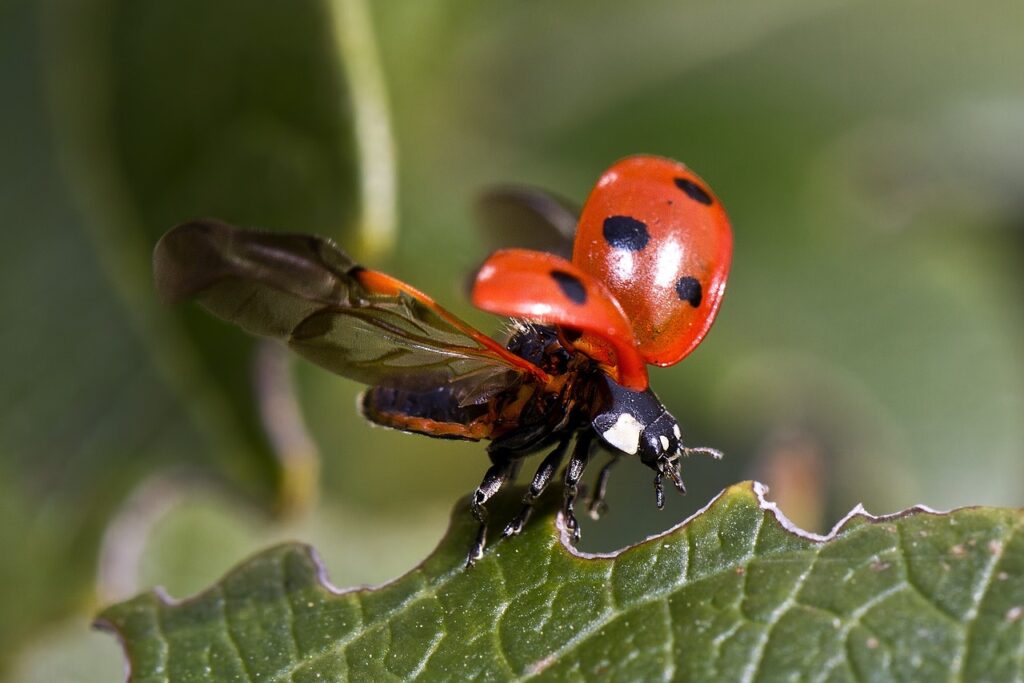
Many coccinellids are known for their distinctive coloration. Most adult lady beetles are red or orange, while others are yellow, pink, brown, black, and everything in between. Many also have black or white spots or stripes on their elytra. In some species, the number of spots can be variable from individual to individual, while in others the number of spots is a species-specific identifier. Some species have no spots at all!
Most lady beetles spend the winter as adults, and some, like the multicolored Asian lady beetle, aggregating in large numbers. To find shelter and warmer microclimates, they will hide out in cracks, crevices, leaf litter, tree bark, log piles, or even in your house or shed to ride out the winter. In temperate areas with cold winters, many lady beetles enter diapause, a physiological state similar to hibernation, where they slow down their metabolism and don’t need to feed.
Most adult coccinellids can live for a year or more.
Lady Beetle Defenses
Usually, when insects have bright coloration with reds, oranges, yellows, blacks, and/or whites, it is a signal that they are toxic or distasteful to predators! In the insect world, this is called aposematism, or warning coloration. While some insects are truly toxic, often consuming toxins through their primary food sources (this happens with Monarch butterfly caterpillars), some insects with warning coloration are simply mimicking other toxic insects to their benefit.
In the case of lady beetles, most are truly toxic! A 2015 study of five lady beetle species found that species with more contrast with their background environment tended to be more toxic.
Aside from being unpalatable to predators, when disturbed, many lady beetles do what’s called “reflex bleeding”—oozing sticky, stinky, bitter droplets of hemolymph (insect blood) from their leg joints to deter predators, like birds.
In addition to chemical defenses, like toxins, some pupae have their own defensive tactics, like the pupa of the spotless lady beetle (Cycloneda sanguinea). It has jaw-like openings on its back that will snap shut at the slightest touch, clamping down on anything that attempts to disturb it.
Lady Beetles as Biological Control Agents
Lady beetles are some of the most popular insects deployed around the world as biological control agents of plants and insects. Biological control, or biocontrol, is the use of living organisms to control insect pests, weeds, and diseases. Whether lady beetles are protected in the home garden, intentionally released in greenhouses and high tunnels, or selectively tested and released to target a specific introduced pest, there is a long history of capitalizing on lady beetles’ predatory behavior.
Cottony Cushion Scale and Vedalia Beetle
The first example of a successful biocontrol release to target an invasive pest involved a lady beetle species! In the late 1800s, a scale insect called cottony cushion scale was wreaking havoc in California citrus groves. Over the winter of 1888-89, a lady beetle called the vedalia beetle (Rodolia cardinalis) was introduced into California from Australia to combat cottony cushion scale. By fall of the following year, the scale was completely controlled in the areas where vedalia beetle had been introduced.
Since the California success, vedalia beetles have been exported to many other parts of the world, often with equally successful results.

Today, lady beetles can be easily purchased online for release in gardens and on farms to combat a variety of common pests. If you’re considering releasing lady beetles in your landscape, do so strategically. Releases of insect predators are most effective in enclosed systems, like greenhouses and high tunnels. When we release a large number of lady beetles, most gardens and landscapes don’t have enough prey insects to support them. The end result is that most end up flying away, dispersing to new areas to find adequate food sources.
A better option is to attract and retain insect predators in your landscape by growing lots of flowers throughout the year (they eat pollen and nectar when prey isn’t readily available), providing water sources like bee cups, and planting plants with lots of different shapes, sizes, and growth habits, where lady beetles can find shelter and reproduce.
When Lady Beetles Become Pests
Although the vast majority of lady beetles are predators, some are actually considered garden pests.
The Mexican bean beetle (Epilachna varivestis), a medium sized, pale orange lady beetle with black spots, is a major pest of legumes for farmers and gardeners alike. It’s one of the few lady beetles in North America that feeds on plants, rather than other insects. It’s native throughout Mexico and the eastern U.S. and can be found chewing holes in green beans, lima beans, favas, cowpeas, soybeans, and more throughout the late spring, summer, and early fall.
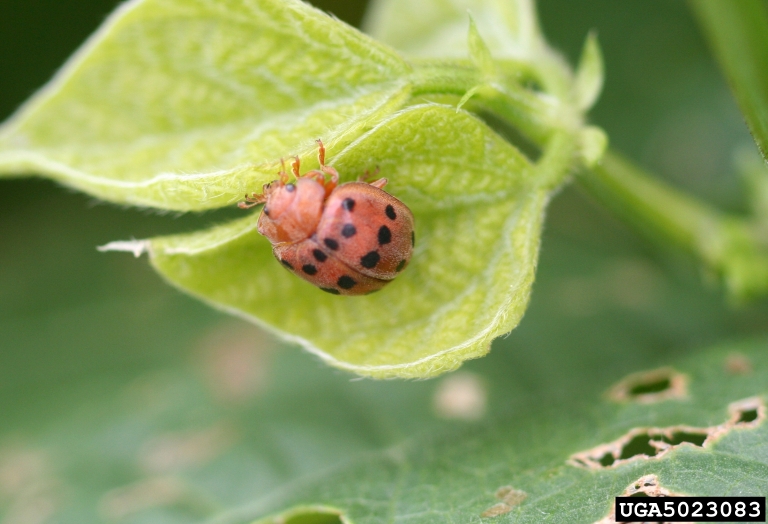
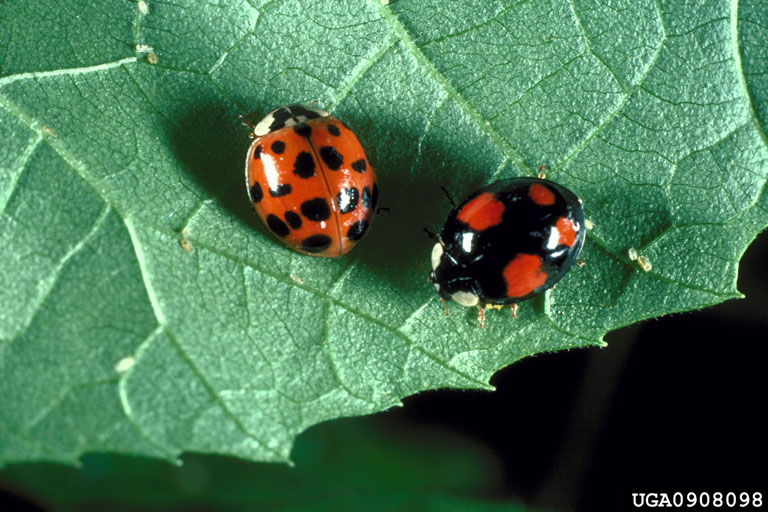
Another lady beetle sometimes considered a nuisance is the multicolored Asian lady beetle (Harmonia axyridis). While this species is in fact a predator of insects like thrips, aphids, scale insects, moth insects, and mites, its pest status comes from its overwintering behavior.
Originally introduced as a biological control agent for aphids, this beetle native to Eurasia, Southeast Asia, and Australia has naturalized in the U.S. and across the world. It usually has red or orange elytra with up to 10 black spots. One of the most identifiable characteristics are the spots on its pronotum, which often join together to look like an “M” or a solid trapezoid.
When the weather starts to get cooler in the fall, H. axyridis adults flock together, sometimes on light-colored, south- or east-facing walls of homes and other buildings. Looking for a cozy place to spend the winter, they wiggle their way into homes through cracks and tiny openings in windows, door frames, and other openings. They spend the winter in these sheltered locations, which can make them an annual or periodic nuisance to many residents.
Despite this behavior, they are our allies in the garden and landscape. As predators, they help to keep nature in balance. The best course of action is to make sure all structural openings in your home are sealed up well, including door sweeps and window frames.
Personal Favorite Lady Beetles
Here are some of my personal favorite lady beetle species that you can find here in Georgia!
The Upshot
There is A LOT of diversity in the world of lady beetles, and its difficult to keep any discussion about them brief. They are some of our most recognizable and beloved insects, and they contribute multitudes to our gardens, landscapes, and natural areas.
If you’re inspired to learn more about lady beetles, check out the resources below!